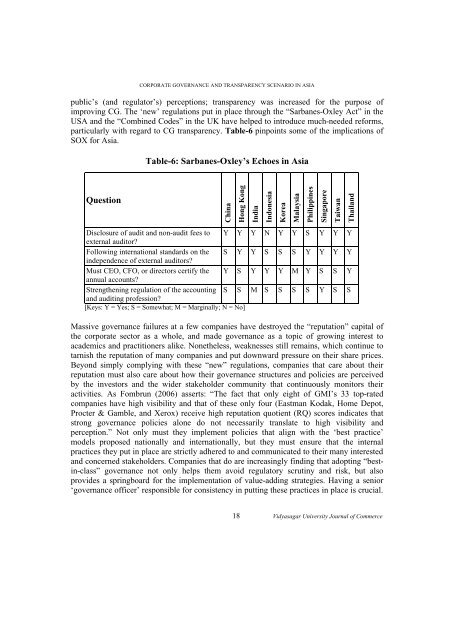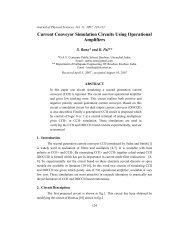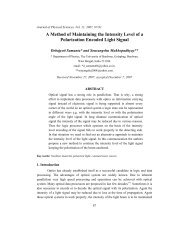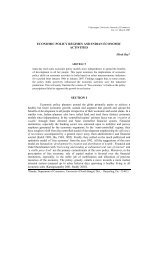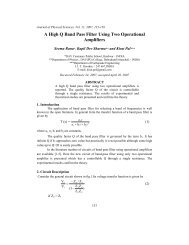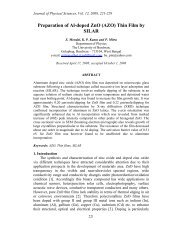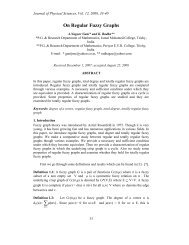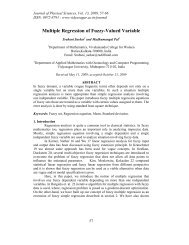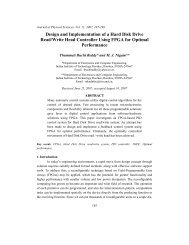VIDYASAGAR UNIVERSITY JOURNAL OF COMMERCE
VIDYASAGAR UNIVERSITY JOURNAL OF COMMERCE
VIDYASAGAR UNIVERSITY JOURNAL OF COMMERCE
Create successful ePaper yourself
Turn your PDF publications into a flip-book with our unique Google optimized e-Paper software.
CORPORATE GOVERNANCE AND TRANSPARENCY SCENARIO IN ASIA<br />
public’s (and regulator’s) perceptions; transparency was increased for the purpose of<br />
improving CG. The ‘new’ regulations put in place through the “Sarbanes-Oxley Act” in the<br />
USA and the “Combined Codes” in the UK have helped to introduce much-needed reforms,<br />
particularly with regard to CG transparency. Table-6 pinpoints some of the implications of<br />
SOX for Asia.<br />
Table-6: Sarbanes-Oxley’s Echoes in Asia<br />
Question<br />
China<br />
Hong Kong<br />
India<br />
Indonesia<br />
Korea<br />
Malaysia<br />
Philippines<br />
Singapore<br />
Taiwan<br />
Thailand<br />
Disclosure of audit and non-audit fees to Y Y Y N Y Y S Y Y Y<br />
external auditor?<br />
Following international standards on the S Y Y S S S Y Y Y Y<br />
independence of external auditors?<br />
Must CEO, CFO, or directors certify the Y S Y Y Y M Y S S Y<br />
annual accounts?<br />
Strengthening regulation of the accounting S S M S S S S Y S S<br />
and auditing profession?<br />
[Keys: Y = Yes; S = Somewhat; M = Marginally; N = No]<br />
Massive governance failures at a few companies have destroyed the “reputation” capital of<br />
the corporate sector as a whole, and made governance as a topic of growing interest to<br />
academics and practitioners alike. Nonetheless, weaknesses still remains, which continue to<br />
tarnish the reputation of many companies and put downward pressure on their share prices.<br />
Beyond simply complying with these “new” regulations, companies that care about their<br />
reputation must also care about how their governance structures and policies are perceived<br />
by the investors and the wider stakeholder community that continuously monitors their<br />
activities. As Fombrun (2006) asserts: “The fact that only eight of GMI’s 33 top-rated<br />
companies have high visibility and that of these only four (Eastman Kodak, Home Depot,<br />
Procter & Gamble, and Xerox) receive high reputation quotient (RQ) scores indicates that<br />
strong governance policies alone do not necessarily translate to high visibility and<br />
perception.” Not only must they implement policies that align with the ‘best practice’<br />
models proposed nationally and internationally, but they must ensure that the internal<br />
practices they put in place are strictly adhered to and communicated to their many interested<br />
and concerned stakeholders. Companies that do are increasingly finding that adopting “bestin-class”<br />
governance not only helps them avoid regulatory scrutiny and risk, but also<br />
provides a springboard for the implementation of value-adding strategies. Having a senior<br />
‘governance officer’ responsible for consistency in putting these practices in place is crucial.<br />
18 Vidyasagar University Journal of Commerce


